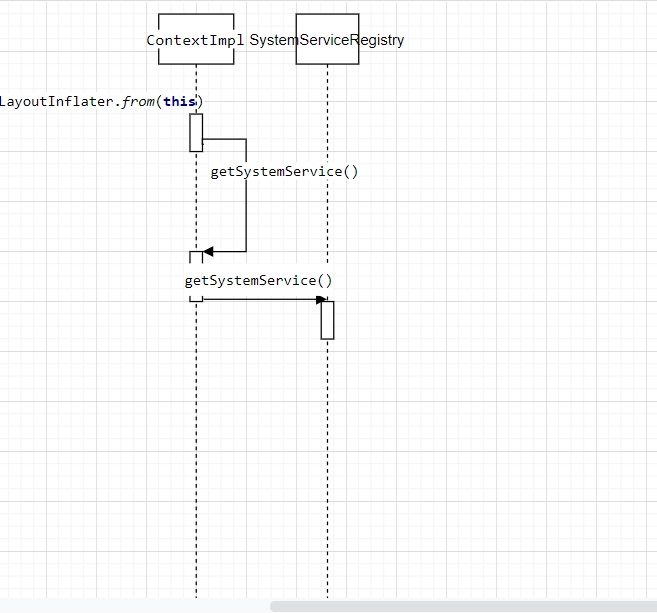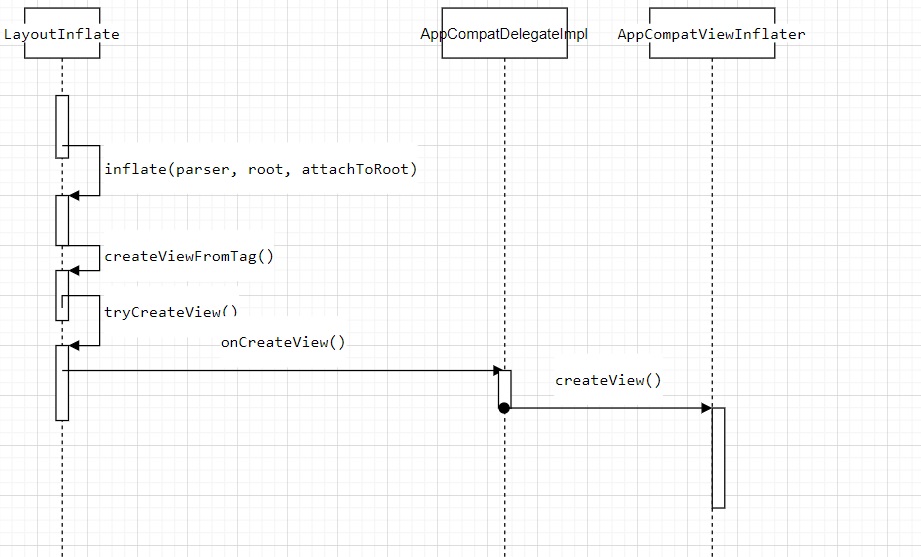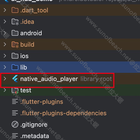首先这里的源码是sdk 29 的也就是Android 10.0的代码,其实和其他的版本区别不大
Inflater 方法的区别
View.inflate(this,R.layout.activity_main,null);
LayoutInflater.from(this).inflate(R.layout.activity_main,null,false);
View.inflate(this,R.layout.activity_main,null);方法里面也是调用LayoutInflater.from(this).inflate(),所以本质还是LayoutInflater.from(this).inflate()这个方法
从LayoutInflater.from()开始
LayoutInflater.from(this)
public static LayoutInflater from(Context context) {
LayoutInflater LayoutInflater =
(LayoutInflater) context.getSystemService(Context.LAYOUT_INFLATER_SERVICE);
if (LayoutInflater == null) {
throw new AssertionError("LayoutInflater not found.");
}
return LayoutInflater;
}
这里的getSystemService()是一个抽象方法,需要找到context的具体实现对象
这里context的实现类是ContextImpl类
看一下UML时序图 
最终走到SystemServiceRegister的getSystemService()方法中
ServiceFetcher<?> fetcher = SYSTEM_SERVICE_FETCHERS.get(name);
SYSTEM_SERVICE_FETCHERS本质是一个ArrayMap,用来存储系统注册的服务
在这里要获取的是Context.LAYOUT_INFLATER_SERVICE这个服务,通过这个服务来获取View
inflate()
观看下面源码解析的时候先看一下时序图 
class LayoutInflater
public View inflate(@LayoutRes int resource, @Nullable ViewGroup root, boolean attachToRoot) {
final Resources res = getContext().getResources();
if (DEBUG) {
Log.d(TAG, "INFLATING from resource: \"" + res.getResourceName(resource) + "\" ("
+ Integer.toHexString(resource) + ")");
}
View view = tryInflatePrecompiled(resource, res, root, attachToRoot);
if (view != null) {
return view;
}
XmlResourceParser parser = res.getLayout(resource);
try {
return inflate(parser, root, attachToRoot);
} finally {
parser.close();
}
}
XmlResourceParser parser = res.getLayout(resource)这个是解析器,用于解析xml
关键在inflate(parser, root, attachToRoot);
tryCreateView()
class LayoutInflater
public final View tryCreateView(@Nullable View parent, @NonNull String name,
@NonNull Context context,
@NonNull AttributeSet attrs) {
if (name.equals(TAG_1995)) {
// Let's party like it's 1995!
return new BlinkLayout(context, attrs);
}
View view;
if (mFactory2 != null) {
view = mFactory2.onCreateView(parent, name, context, attrs);
} else if (mFactory != null) {
view = mFactory.onCreateView(name, context, attrs);
} else {
view = null;
}
if (view == null && mPrivateFactory != null) {
view = mPrivateFactory.onCreateView(parent, name, context, attrs);
}
return view;
}
这里会判断mFactory2、mFactory、mPrivateFactory是否为空,不为空就调用相应的onCreateView()方法。
回到createViewFromTag()方法观看下面,
View createViewFromTag(View parent, String name, Context context, AttributeSet attrs,
....
try {
View view = tryCreateView(parent, name, context, attrs);
if (view == null) {
final Object lastContext = mConstructorArgs[0];
mConstructorArgs[0] = context;
try {
if (-1 == name.indexOf('.')) {
view = onCreateView(context, parent, name, attrs);
} else {
view = createView(context, name, null, attrs);
}
} finally {
mConstructorArgs[0] = lastContext;
}
}
return view;
....
}
当mFactory2、mFactory、mPrivateFactory为空,那么view也是null,那么会用自己的onCreateView()方法,注意这里的if(-1 == name.indexOf('.'))
name是使用xml解析工具解析xml文件获取到的属性,这个是判断有没有自己定义的控件如com.example.TestText这种自己定义的控件,那么就调用相应的创建方法。
好,回到上面tryCreateView()方法中,这个mFactory什么时候被赋值,在哪里赋值?
经过一番最终和查找,发现在AppCompatActivity中的OnCreate() 中有一个delegate.installViewFactory();方法,点进去就是在 AppCompatDelegateImpl类中 installViewFactory() 方法中将Factory赋值
赋值Factory
class AppCompatDelegateImpl
public void installViewFactory() {
LayoutInflater layoutInflater = LayoutInflater.from(mContext);
if (layoutInflater.getFactory() == null) {
LayoutInflaterCompat.setFactory2(layoutInflater, this);
} else {
if (!(layoutInflater.getFactory2() instanceof AppCompatDelegateImpl)) {
Log.i(TAG, "The Activity's LayoutInflater already has a Factory installed"
+ " so we can not install AppCompat's");
}
}
}
LayoutInflaterCompat.setFactory2(layoutInflater, this);将自己传入进去,那么LayoutInflate类走的onCreateView()方法就是LayoutInflaterCompat.onCreateView() 继续往下走就是走的**AppCompatViewInflater.onCreate()**方法,然后我们可以看到
class AppCompatViewInflater
final View createView(View parent, final String name, @NonNull Context context,
@NonNull AttributeSet attrs, boolean inheritContext,
boolean readAndroidTheme, boolean readAppTheme, boolean wrapContext) {
final Context originalContext = context;
// We can emulate Lollipop's android:theme attribute propagating down the view hierarchy
// by using the parent's context
if (inheritContext && parent != null) {
context = parent.getContext();
}
if (readAndroidTheme || readAppTheme) {
// We then apply the theme on the context, if specified
context = themifyContext(context, attrs, readAndroidTheme, readAppTheme);
}
if (wrapContext) {
context = TintContextWrapper.wrap(context);
}
View view = null;
// We need to 'inject' our tint aware Views in place of the standard framework versions
switch (name) {
case "TextView":
view = createTextView(context, attrs);
verifyNotNull(view, name);
break;
case "ImageView":
view = createImageView(context, attrs);
verifyNotNull(view, name);
break;
case "Button":
view = createButton(context, attrs);
verifyNotNull(view, name);
break;
....
default:
// The fallback that allows extending class to take over view inflation
// for other tags. Note that we don't check that the result is not-null.
// That allows the custom inflater path to fall back on the default one
// later in this method.
view = createView(context, name, attrs);
}
if (view == null && originalContext != context) {
// If the original context does not equal our themed context, then we need to manually
// inflate it using the name so that android:theme takes effect.
view = createViewFromTag(context, name, attrs);
}
if (view != null) {
// If we have created a view, check its android:onClick
checkOnClickListener(view, attrs);
}
return view;
}
这里会看一下解析出来的属性有没有Button、TextView、ImageView等等,有的话就会为我们创建相应的View, view = createViewFromTag(context, name, attrs);这一行是用来处理那一些自定义View,通过反射将对象new出来。跟上面一样。
这样AppCompatViewInflater就对View的创建进行了拦截。这个就是View的Inflater加载大概过程。
自己拦截View的创建
看了上面的源码,我们可以尝试一下自己来进行拦截View的创建,尝试拦截View将所有Button变成TextView
public class BaseActivity extends AppCompatActivity {
@Override
protected void onCreate(@Nullable Bundle savedInstanceState) {
LayoutInflater layoutInflater = LayoutInflater.from(this);
LayoutInflaterCompat.setFactory(layoutInflater,new LayoutInflaterFactory(){
@Override
public View onCreateView(View parent, String name, Context context, AttributeSet attrs) {
Log.d("TAG","拦截view的创建");
if(name.equals("Button")){
TextView tv = new TextView(BaseActivity.this);
tv.setText("拦截");
return tv;
}
return null;
}
});
super.onCreate(savedInstanceState);
....
}
}




























